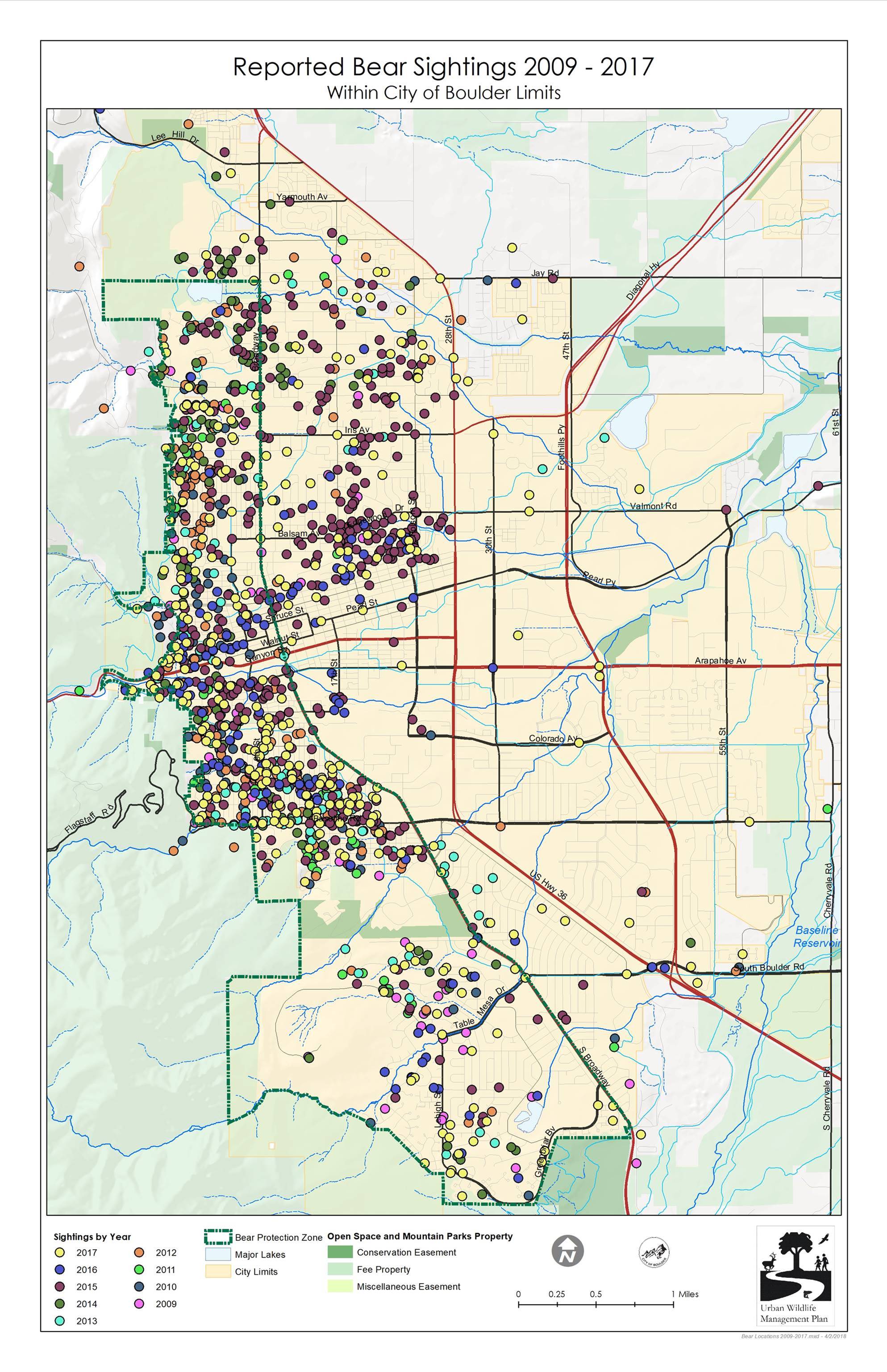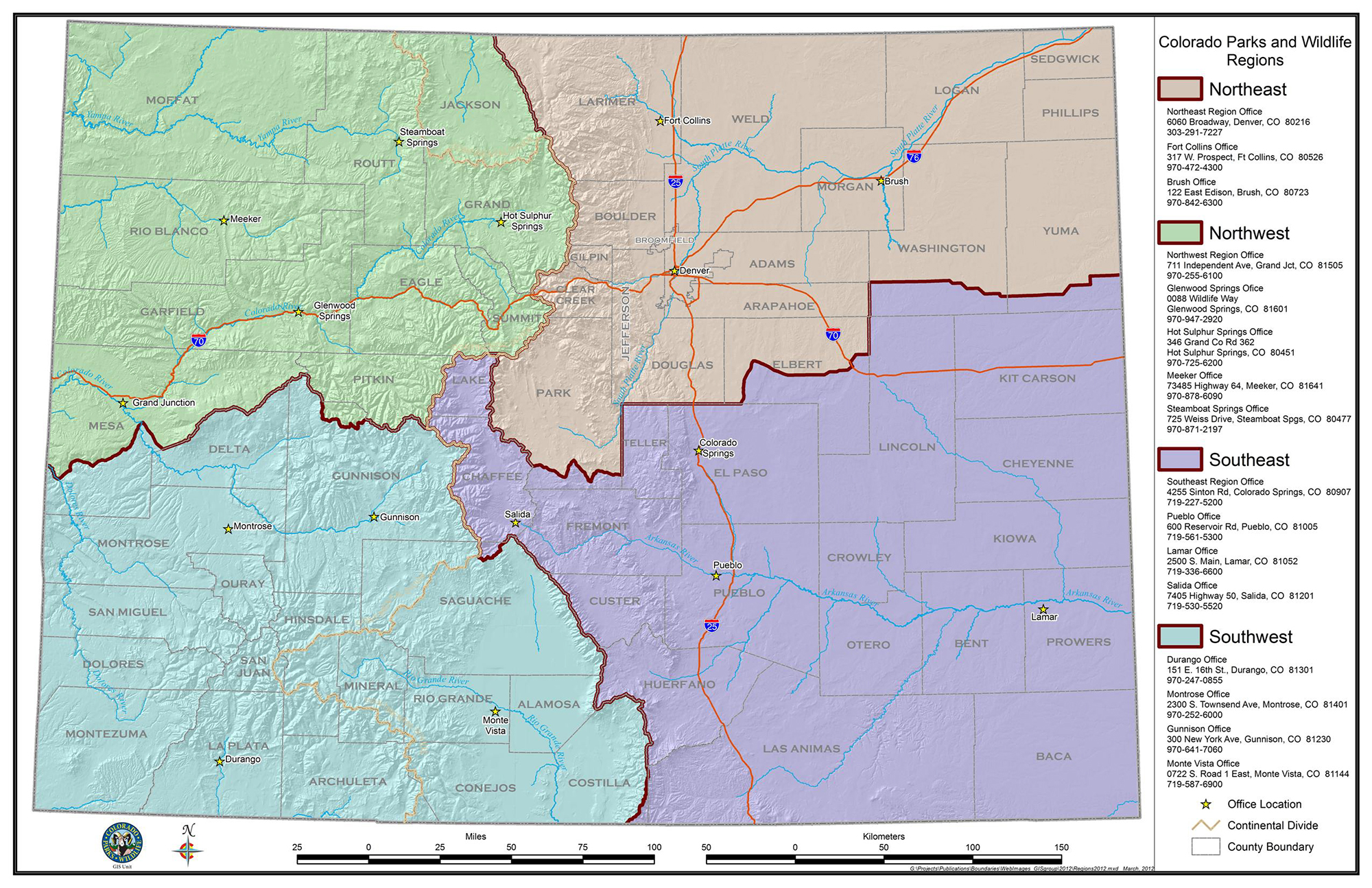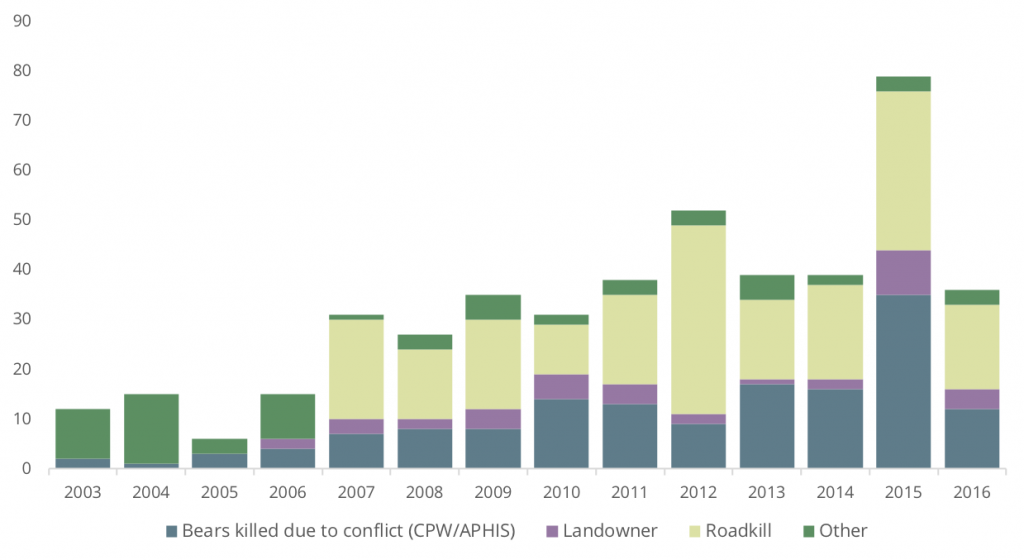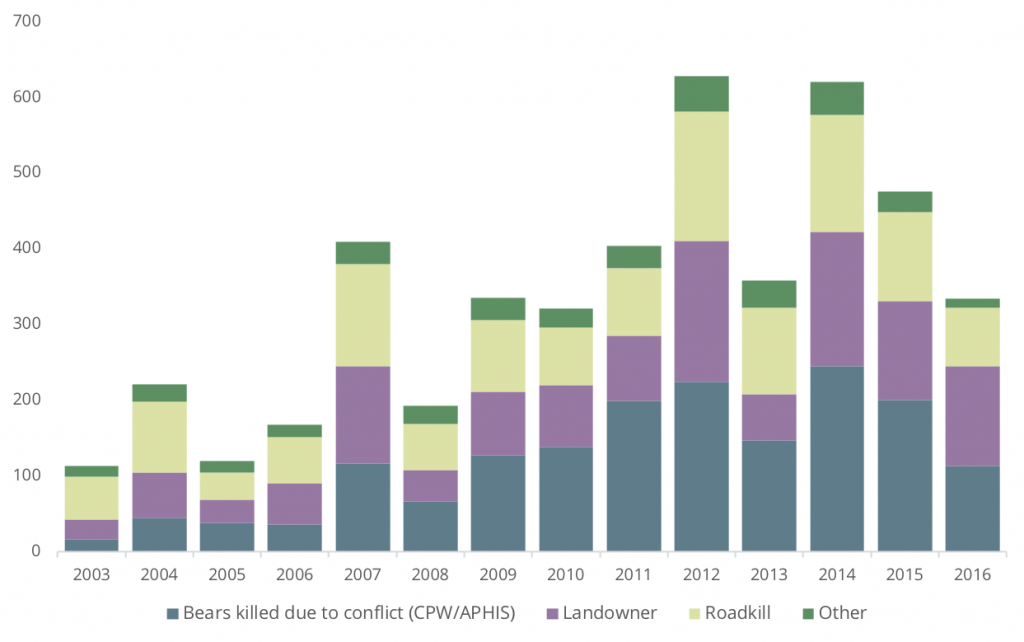With human populations increasing and natural habitats shrinking, it’s likely that human-bear conflicts will continue to rise in the coming years.
The problem stems from rapid human development and bears seeking out human-provided food such as garbage, fruit, pet food, livestock, and bird seed. Colorado Parks and Wildlife’s 2015 Human Bear Conflict Report (HBCR) explains that human populations in Colorado are on track to exceed 7.1 million people by 2040, with much of that growth taking place in the Front Range, where a significant amount of the state’s black bear habitat exists. Black bear populations, on the other hand, are extremely hard to estimate due to the high costs and challenges of tracking a solitary animal. Considering this, the current, conservative black bear population estimate for the state of Colorado is somewhere between 17,000 to 20,000 individual bears. CPW requires a mandatory check for all types of human-caused bear mortality, which includes everything from hunting, to conflict-related incidents between landowners or wildlife authorities, to roadkill, and accidental deaths like drowning or electrocution. With this mortality information, wildlife managers have confirmed that the black bear population throughout the state has declined since 2011 (HBCR, page 6).
Looking into further detail, the intensity of these negative interactions between humans and bears does vary from year to year, and from place to place throughout Colorado. However, data shows that overall conflicts are generally increasing. Below, data is separated out on the basis of four regions: Boulder city limits, Boulder County, the northeast region of Colorado, and the entire state of Colorado. Due to the variety of data collection efforts from each region, available statistics vary and are explained in greater detail.
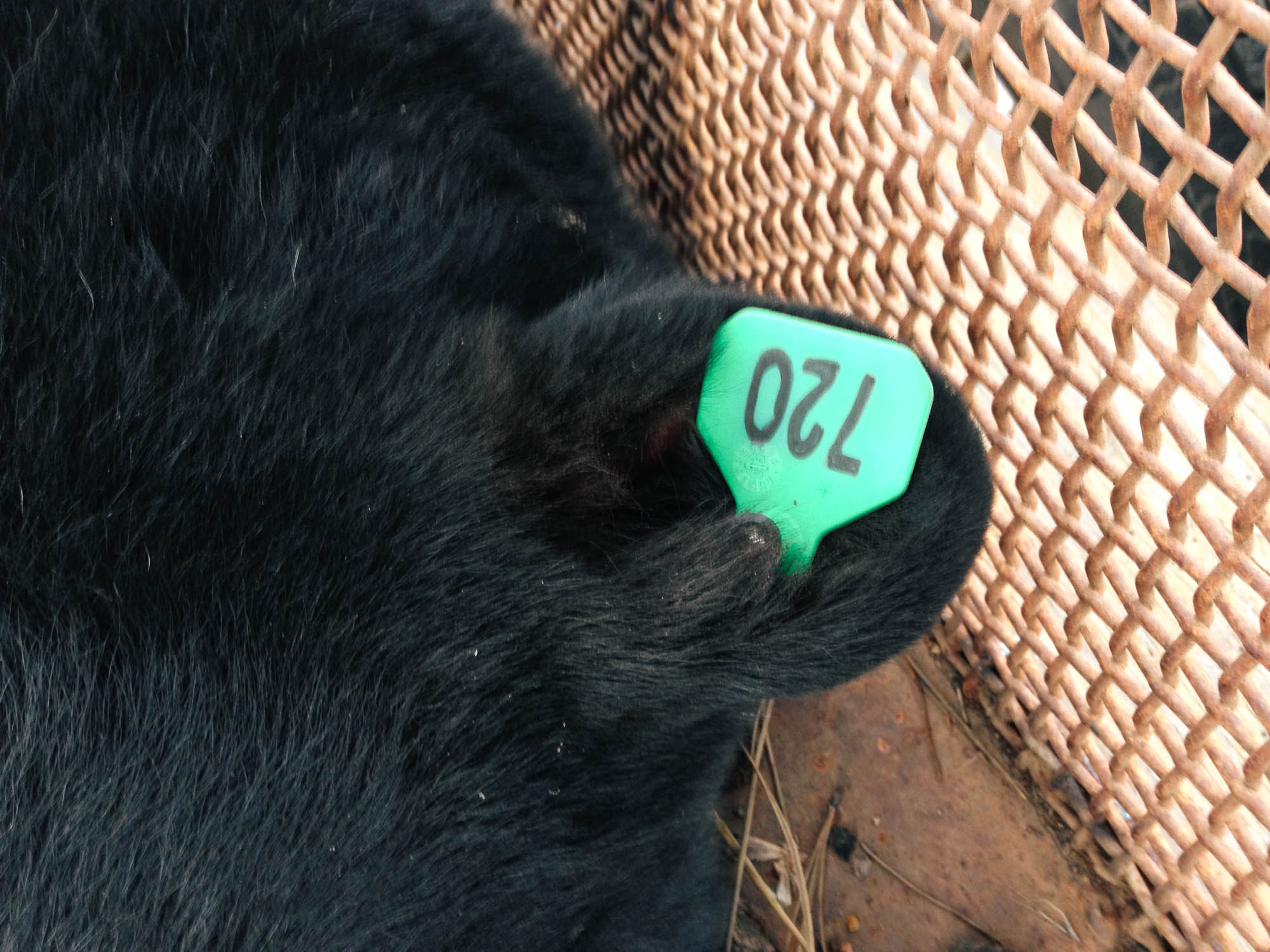
Male subadult bear #720 in the process of being relocated upon receiving his first strike in August 2013. Photo courtesy Jason Duetsch.
Videos sent to the Bears & People Project by a Boulder resident
Compared to other years, 2013 proved to be a deadly year for bears within Boulder’s city limits.
Beginning in Boulder city limits, data is available from 2003-2017 and includes the number of individual bears killed by Colorado Parks and Wildlife (CPW) due to conflict, hit by cars, and euthanized due to reasons other than conflict (injury, illness, etc.). These records are available thanks to the City of Boulder’s Urban Wildlife Conservation Coordinator, Valerie Matheson. After talking with Matheson, I learned that Boulder’s data collection efforts are unique compared to other cities, which demonstrates the city’s dedication to understanding trends related to bear conflicts. Few other cities track wildlife conflict data like the City of Boulder does.
Compared to other years, 2013 was a deadly year for bears, with four individual bears killed within Boulder city limits after becoming “nuisances” and habituated to trash, six bears requiring relocation, and two bears being hit by cars. One common thread runs through the four bears that were killed: they were eating trash. Although it can’t be said for certain, the incidents involving the three euthanized bears in September and the October 11th roadkill bear took place either during, or shortly after, Boulder’s 2013 floods. From September 8-16, 2013, more than 18 inches of rain fell in Boulder, causing significant flooding, loss of life, widespread damage, and displaced wildlife in the area. It’s also necessary to mention that the Bear Protection Ordinance was not yet implemented until 2014. According to Colorado Parks and Wildlife officer Kristin Cannon, issues with bears and trash had come to a head that year.
Bear Mortalities within Boulder’s City Limits
According to CPW’s mortality reports, here’s what happened to the bears that died in 2013:
Bear #1: May 21, 2013
One subadult male bear entered two different houses within a two-hour period in the city of Boulder. This brown-colored bear had no ear tags or strikes against him, but was however sighted numerous times with his sibling around the Columbia Cemetery. After being tranquilized, he was destroyed for posing human safety concerns.
Bear #2: September 8, 2013
A large black-colored adult bear, #744, turned up in a backyard just west of Flatirons Elementary School. #744 was a very large, dominant boar, weighing in at about 590 lbs. The bear was quite old and wore many scars from fighting with other bears. He was a town regular and previously required relocation after getting into trash, and here he was once again, getting into trash. This time he wouldn’t leave and also caused damage to a resident’s fence and was showing little to no fear of humans. He was euthanized at ~10 yards away; this was his 2nd strike.
Bear #3: September 14, 2013
This particular day brought wildlife officers to the Columbia Cemetery nearby 8th & Pleasant Street. Another repeat trash offender, #720 was an adult black-colored bear that had been relocated less than one month prior to his death. This bear reportedly allowed people to get very close to him to take pictures while he was eating garbage. Once #720 returned back to the city and continued to display nuisance behavior, he was euthanized; this was his 2nd strike.
Bear #4: September 30, 2013
Another repeat trash offender, brown-colored sow #609 was euthanized after getting into trash in downtown Boulder. In October 2011, #609 received her first strike after showing nuisance behavior nearby University Hill, and was moved to Caribou Ranch Open Space. CPW notes that she returned to downtown Boulder within 6 days and was seen in town almost every day during the summer of 2013. She had two cubs with her when she was killed on September 30th, her 2nd strike. #609’s orphaned cubs, one black-colored male, and one brown-colored male, were tagged as #719 and #721. The cubs were relocated to Kremmling, CO and #721 was destroyed by CPW in July 2014 due to conflict, while his sibling #719 was harvested by a hunter in September 2016.
Bears #5 and 6: Roadkill
The two bears that were hit by cars within city limits did not have any previous strikes against them, so no other historical information is available. What we do know is the first bear was a male subadult and was hit by a car on May 10, 2013 on Diagonal Highway, nearby the Cottonwood Trail. On October 11, 2013, a cub was killed by a car on south Foothills Parkway.
Bears killed due to conflict: City vs. County
Black bears have no concept of city or county boundaries.
Expanding bear mortality stats out to the broader Boulder County is rather challenging, as Matheson, an employee of the City of Boulder, only tracks the city incidents. All conflict reports are tracked by Colorado Parks and Wildlife officers, however the agency does not have a user-friendly database system currently established. After receiving permission to spend a full day at CPW’s Loveland, CO headquarters, I was able to dig up the following conflict-related bear mortality data in from Boulder County. CPW data is organized in terms of Game Management Units (GMU), areas, and districts, not necessarily counties. Boulder County is divided into GMUs 20 and 29, and considering that Larimer County is also included in GMU 20, things get a bit complicated as the forms are all handwritten hard copies and not necessarily sorted out by county. Due to the fact that some paperwork was out of order, I can say for certain that the Boulder County numbers should be viewed on an “at least” basis. There is a possibility more CPW-induced bear mortality reports exist, but may have been missed due to the system’s current setup.
*County numbers include City of Boulder mortalities.
Bears killed throughout the county may have very well been a problem within Boulder’s city limits before being destroyed in the county or elsewhere.
Although there is not enough data available to demonstrate any obvious trends from year-to-year throughout Boulder County, I felt the data was still quite valuable. Even though years like 2014 and 2016 show zero conflict-related bear mortalities in the city of Boulder, there were bears that required lethal action just beyond that region, in the larger county. This is important to consider, as black bears have no concept of city or county boundaries. The moment a nuisance bear walks out of the city, into the wider county, and is destroyed, it will not be included in the city’s database. That is not irrelevant, as nuisance bears have large territories, ranging upwards of 250 square miles, depending on available habitat and forage. Bears killed throughout the county may have very well been a problem within Boulder’s city limits before being destroyed in the county or elsewhere. It’s also possible that the city’s Bear Protection Ordinance, which requires residents west of Broadway and south of Sumac Avenue to use bear-resistant waste bins, could be so successful that the bears are beginning to disperse further east.
Draft maps of bear sightings, as provided by Valerie Matheson below, do show that this may be the case. Failure to obtain the reward of garbage in west Boulder’s bear-resistant waste bins may instead encourage the bears to continue on through the city, even out to areas as far east as Longmont. As seen in the maps below, bears have indeed been sighted further east in 2017 vs. previous years. While the 2015 sightings seem to be extremely high, it’s important to note that this is the first year the city was able to incorporate call data from the Boulder Police Department’s Dispatch line. It’s not necessarily that 2015 had more bear sightings, but that the data collection efforts improved drastically. Also worth considering is the fact that these are not verified sightings, and some residents may choose to report bear activity while others will not.
Additional bear mortality numbers dating back to 1995 were provided to me by CPW officer Kristin Cannon as a personal communication. This information is not yet published anywhere and should be viewed as draft, unofficial records. This particular data, as demonstrated in two remaining charts, is separated into two areas: the northeast region of Colorado, and the entire state of Colorado. Black bear mortalities are displayed in the following mortality categories: CPW, landowner, ADC/APHIS (Animal Damage Control and Animal and Plant Health Inspection Service), and other. “Other” mortalities include roadkills, sheriff’s officers, hikers, carcass found, etc. Separate tables for each region are split up to specifically demonstrate how many roadkill deaths were in the “other” categories. “Other” and “roadkill” mortalities should be read on an “at least” basis, as these types of bear mortalities are not always reported to wildlife officials. It is quite possible that this number is higher in actuality. The City of Boulder and Boulder County are both included in CPW’s northeast region. Statistics for the northeast region as well as the entire state are included in my research to demonstrate the scale of conflict-related bear mortalities in a much larger sense, while still linking to Boulder’s city and county boundaries.
Bear mortalities vary from year to year, however they appear to be following an upward trend.
Unofficial reports from the northeast region of Colorado as well as the entire state of Colorado are broken out in the tables to the right to show the combined number of bears killed due to conflict by CPW and APHIS, bears killed by landowners as permitted by Statute 33-3-106 of Colorado’s Nuisance Wildlife Laws, bear roadkill mortalities, and other mortalities. None of these statistics include hunter harvests. Similar to Boulder’s city and county limits, bear mortalities do vary from year to year; however they appear to be following a general upward trend.
It’s necessary to understand that conflicts between humans and bears will continue unless people take action to proactively secure attractants from the bears and practice safe hazing techniques. Educating residents, implementing policies, and enforcing those policies is not the responsibility of one single agency like Colorado Parks and Wildlife, but should be a cooperative effort involving the city, county, state, and citizens.
“Going forward, it is critical to keep in mind that all credible research and practical experience suggests that efforts to reduce bear populations alone will not reduce human conflicts. To address this problem effectively, simultaneous efforts must be made to influence human behavior and practices, including improvements to waste management methods and enacting and strictly enforcing effective local ordinances.”
As stated in Colorado Parks and Wildlife’s 2015 Human Bear Conflict Report

